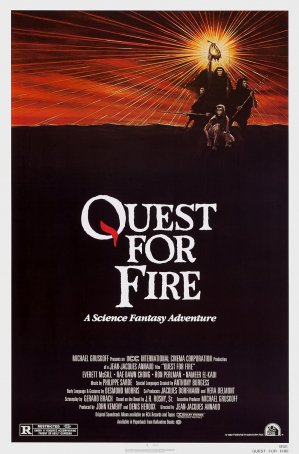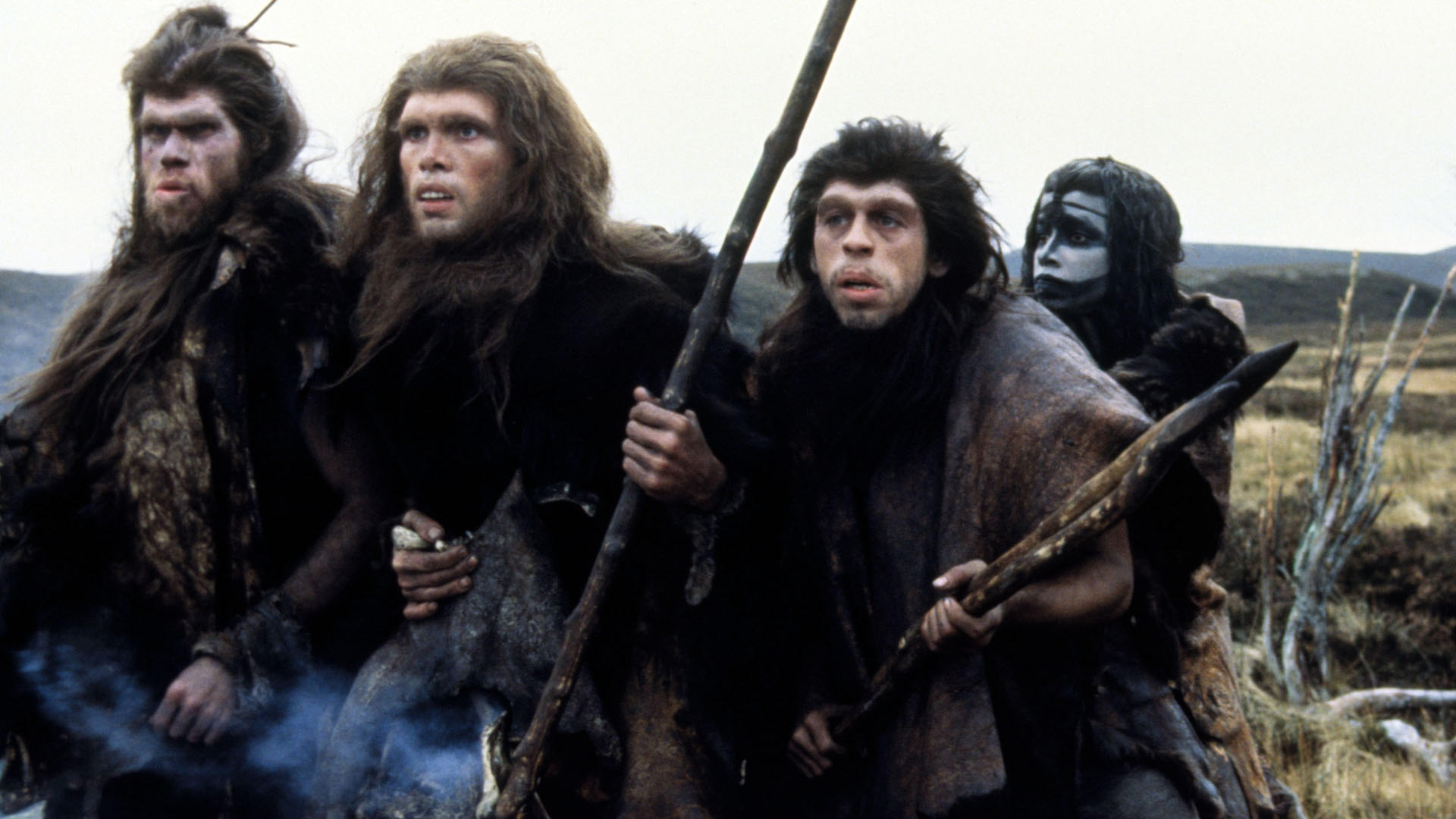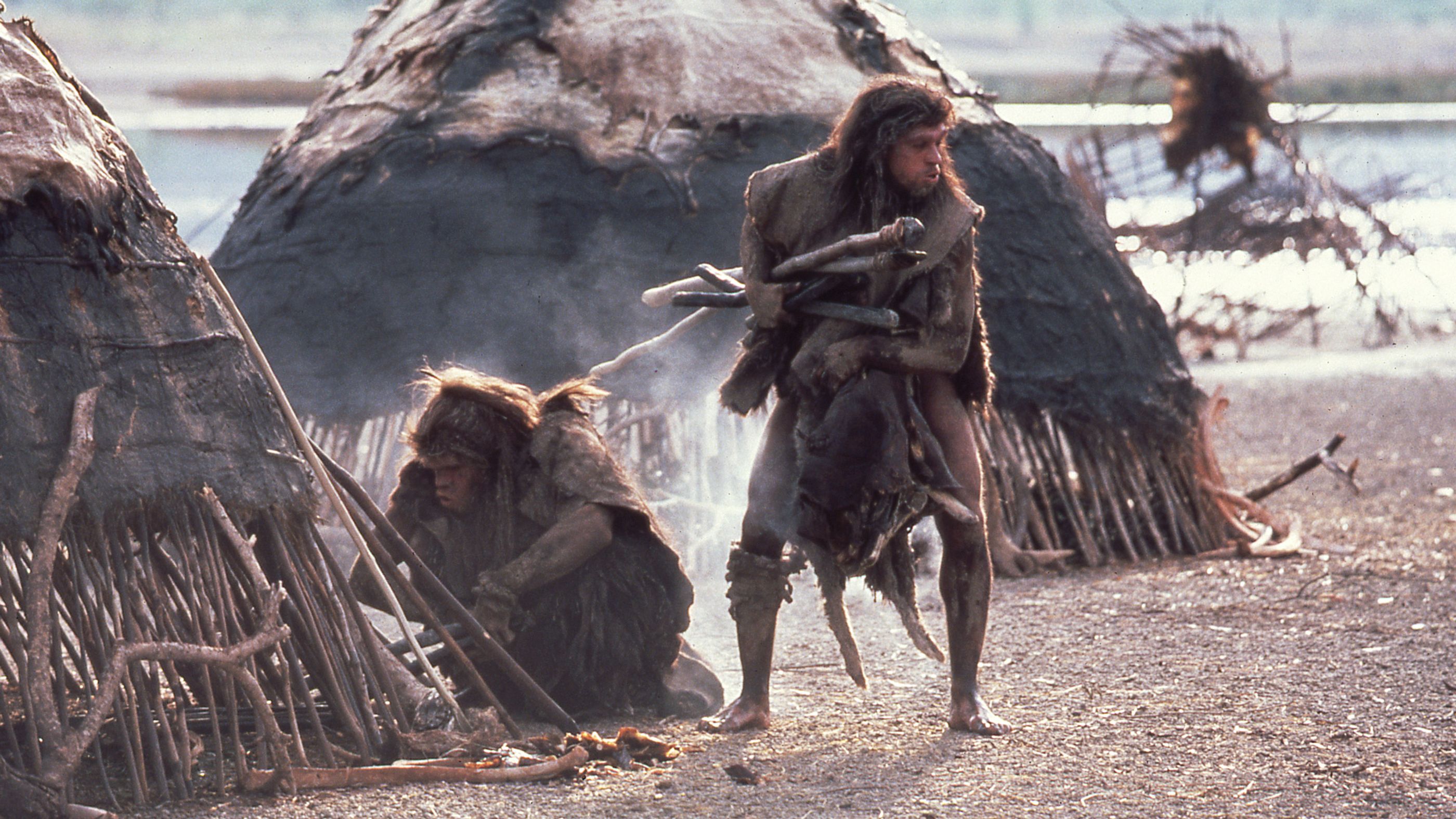Quest for Fire (Canada/France, 1981)
March 08, 2024
At least at first, a viewer can be forgiven some consternation understanding what director Jean-Jacques Annaud is attempting to achieve with Quest for Fire. With its Neanderthal-like characters leaping around like apes, the film sometimes feels more like an episode of the old Saturday morning TV show Land of the Lost than a serious probing of how prehistoric humans might have lived their day-to-day lives. Is this a comedy (perhaps unintentionally so)? Is it a drama? Or is it perhaps a little of both? The more accustomed we become to Annaud’s interpretation of life at the dawn of humanity, the less alien it seems – an examination of an ancient culture with unfamiliar customs and morals. (Cannibalism and rape appear to be fairly commonplace occurrences, although the former is met with disgust on one occasion.)
Across a career that has spanned 45 years, Annaud has defied pigeonholing, being equally comfortable directing commercial projects and art-house affairs. His 1976 debut, Black and White in Color received an Oscar for Best Foreign Language Film. Subsequent projects included The Name of the Rose with Sean Connery and Christian Slater, the soft-core porn art-film The Lover, Seven Years in Tibet, and Enemy at the Gates. None of his movies have been quite as off the beaten path as Quest for Fire.
 The story transpires at an unspecified time in the distant
past. It follows the journey of three members of the Ulam tribe – Naoh (Everett
McGill), Amoukar (Ron Perlman), and Gaw (Nameer El-Kadi) – as they embark on a
quest to replace the fire their people relied on but which was lost during a
battle with the more primitive Wagabu. Their journey takes them to new places
and provides a variety of encounters, including a near-escape from saber-tooth
tigers and an interaction with a group of mammoths. A young woman, Ika (Rae Dawn
Chong), joins them along the way and becomes attached to Naoh, who “claims” her
to prevent Amoukar from doing so. Ika eventually leads the three men to the
land of her tribe, the Ivanka, a more advanced group that knows how to make
fire and lives in constructed shelters. Naoh is captured and forced to mate
with several women; when Amoukar and Gaw attempt a rescue, he is reluctant to
come with them so, with Ika’s help, they knock him out and drag him away. When
the quartet rejoins the Ulam, they come armed with the knowledge of how to make
fire.
The story transpires at an unspecified time in the distant
past. It follows the journey of three members of the Ulam tribe – Naoh (Everett
McGill), Amoukar (Ron Perlman), and Gaw (Nameer El-Kadi) – as they embark on a
quest to replace the fire their people relied on but which was lost during a
battle with the more primitive Wagabu. Their journey takes them to new places
and provides a variety of encounters, including a near-escape from saber-tooth
tigers and an interaction with a group of mammoths. A young woman, Ika (Rae Dawn
Chong), joins them along the way and becomes attached to Naoh, who “claims” her
to prevent Amoukar from doing so. Ika eventually leads the three men to the
land of her tribe, the Ivanka, a more advanced group that knows how to make
fire and lives in constructed shelters. Naoh is captured and forced to mate
with several women; when Amoukar and Gaw attempt a rescue, he is reluctant to
come with them so, with Ika’s help, they knock him out and drag him away. When
the quartet rejoins the Ulam, they come armed with the knowledge of how to make
fire.
 If the viewer is able to buy into some of the more ridiculous
aspects of the movie and cope with the absence of intelligible dialogue (the
characters interact through a combination of gestures and grunts), Quest for
Fire emerges as an engaging adventure film. It becomes a prehistoric road movie
of sorts and, as with all road movies, the journey is more important than the destination.
And, just as one wouldn’t call a movie The Search for Spock if Spock wasn’t
going to be found, so one wouldn’t call this film Quest for Fire if the
end-game didn’t involve the recovery of fire.
If the viewer is able to buy into some of the more ridiculous
aspects of the movie and cope with the absence of intelligible dialogue (the
characters interact through a combination of gestures and grunts), Quest for
Fire emerges as an engaging adventure film. It becomes a prehistoric road movie
of sorts and, as with all road movies, the journey is more important than the destination.
And, just as one wouldn’t call a movie The Search for Spock if Spock wasn’t
going to be found, so one wouldn’t call this film Quest for Fire if the
end-game didn’t involve the recovery of fire.
Three of the four principal actors in Quest for Fire appeared in this movie at the beginning of successful careers. Everett McGill, who is arguably best-known today for his role as Big Ed in David Lynch’s Twin Peaks (in its various incarnations), was a little-known TV performer at this time. Ron Perlman, the future frequent collaborator of Guillermo del Toro, made his debut here. This was also an early appearance for Rae Dawn Chong (one of Tommy Chong’s children), whose frequent nudity was often obfuscated by camera placement and body paint. (One could not accuse Quest for Fire as being shot using the so-called “male gaze.”)
 Although anthropologist Desmond Morris was brought on board
as a consultant, Quest for Fire is not accepted to be an accurate
depiction of anything. What it offers, however, is the opportunity to contemplate
the difficulties of living in these circumstances and the criticality of fire
to human development. Like other films depicting people during the “cave man”
stage of development (another example being the laughably bad Clan of the
Cave Bear, which came out five years later), the movie is easily mistaken
for a comedy/parody and there’s a sense that Annaud approaches the material
with an awareness that this would be the case. Roger Ebert, for example,
enjoyed the movie while acknowledging it to be a “borderline comedy” and it is
best experienced in those terms. It’s at times funny and at other times
touching – Naoh’s attempts to understand his developing romantic feelings for
Ika humanize (for lack of a better term) him and give the movie an added dimension.
Quest for Fire was a box office failure upon its release but, although
it hasn’t gained much of a following over the years, it is at least as
effective (if not more so) as when Annaud assembled it.
Although anthropologist Desmond Morris was brought on board
as a consultant, Quest for Fire is not accepted to be an accurate
depiction of anything. What it offers, however, is the opportunity to contemplate
the difficulties of living in these circumstances and the criticality of fire
to human development. Like other films depicting people during the “cave man”
stage of development (another example being the laughably bad Clan of the
Cave Bear, which came out five years later), the movie is easily mistaken
for a comedy/parody and there’s a sense that Annaud approaches the material
with an awareness that this would be the case. Roger Ebert, for example,
enjoyed the movie while acknowledging it to be a “borderline comedy” and it is
best experienced in those terms. It’s at times funny and at other times
touching – Naoh’s attempts to understand his developing romantic feelings for
Ika humanize (for lack of a better term) him and give the movie an added dimension.
Quest for Fire was a box office failure upon its release but, although
it hasn’t gained much of a following over the years, it is at least as
effective (if not more so) as when Annaud assembled it.
Note: The copy currently available for streaming at Amazon Prime is nearly-unwatchable and should be avoided at all costs. It appears to be a dupe of a pan-and-scan VHS copy that was originally recorded at SLP speed. It is virtually unwatchable. Other, better copies are available for rent and anyone who is serious about watching the movie is advised to seek those out.
Quest for Fire (Canada/France, 1981)
Cast: Everett McGill, Ron Perlman, Nameer El-Kadi, Rae Dawn Chong
Home Release Date: 2024-03-08
Screenplay: Gerard Brach, based on the novel by J.H. Rosny Sr.
Cinematography: Claude Agostini
Music: Philippe Sarde
U.S. Distributor: 20th Century Fox
U.S. Home Release Date: 2024-03-08
MPAA Rating: "R" (Violence, Nudity, Sexual Content)
Genre: Fantasy/Adventure
Subtitles: In Prehistoric Language with no subtitles
Theatrical Aspect Ratio: 2.35:1
- (There are no more better movies of Everett McGill)
- (There are no more worst movies of Everett McGill)
- (There are no more better movies of Nameer El-Kadi)
- (There are no more worst movies of Nameer El-Kadi)
Comments